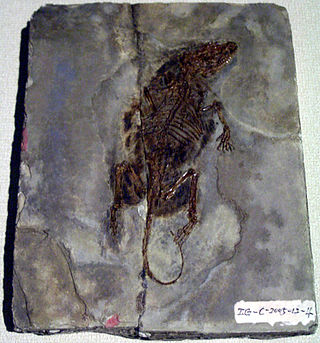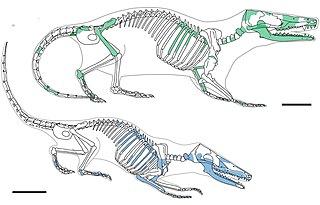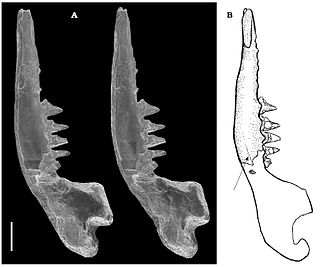
Maotherium is a genus extinct symmetrodont mammal that was discovered in Early Cretaceous rocks in Liaoning Province, China, in 2003. Its scientific name directly translates to "fur beast", in reference to the impressions of fur around the fossil. Maotherium belongs to an extinct group of Mesozoic mammals called symmetrodonts. Though little is known about this group, the symmetrodonts have several similarities - specifically their teeth. They have tall pointed, but simple molars in a triangular arrangement. Originally symmetrodonts were known since the 1920s. Now a vast majority have been restored, such as Zhangheotherium and Akidolestes, during the early 21st century. One of the fossils of Maotherium preserved the imprints of fur, like the mammals Eomaia and Sinodelphys.

Zhangheotherium is an extinct genus of "symmetrodont" mammal from the Early Cretaceous of China. A single species is known, Zhangheotherium quinquecuspidens from Jianshangou Beds of the Yixian Formation. Zhangheotherium was the first "symmetrodont" known from a nearly complete skeleton, expanding knowledge of the group beyond isolated teeth and jaws. The genus name honors Zhang He, who collected the holotype fossil from Liaoning Province prior to its 1997 description. The specific name is Latin for "five-cusped teeth".

Akidolestes is an extinct genus of mammals from the family spalacotheriid.

Docodonta is an order of extinct Mesozoic mammaliaforms. They were among the most common mammaliaforms of their time, persisting from the Middle Jurassic to the Early Cretaceous across the continent of Laurasia. They are distinguished from other early mammaliaforms by their relatively complex molar teeth. Docodont teeth have been described as "pseudotribosphenic": a cusp on the inner half of the upper molar grinds into a basin on the front half of the lower molar, like a mortar-and-pestle. This is a case of convergent evolution with the tribosphenic teeth of therian mammals. There is much uncertainty for how docodont teeth developed from their simpler ancestors. Their closest relatives may have been certain Triassic "symmetrodonts", namely Woutersia, Delsatia, and Tikitherium.
Kuehneotheriidae is an extinct family of mammaliaforms traditionally placed within 'Symmetrodonta', though now generally considered more basal than true symmetrodonts. All members of Kuehneotheriidae which have been found so far are represented only by teeth, but these teeth have features which have led paleontologists to classify kuehneotheriids as very close relatives of the first true mammals. But fossil clades based solely on teeth often lead to difficulties, and it is not possible to draw significant conclusions about mammalian evolution from Kuehneotheriidae unless some more complete skeletons are found.

Eutriconodonta is an order of early mammals. Eutriconodonts existed in Asia, Africa, Europe, North and South America during the Jurassic and the Cretaceous periods. The order was named by Kermack et al. in 1973 as a replacement name for the paraphyletic Triconodonta.

Yanoconodon is a monotypic genus of extinct early mammal whose representative species Yanoconodon allini lived during the Mesozoic in what is now China. The holotype fossil of Yanoconodon was excavated in the Yan Mountains about 300 kilometres from Beijing in the Qiaotou member of the Huajiying Formation of Hebei Province, China, and is therefore of uncertain age. The Qiaotou Member may correlate with the more well-known Early Cretaceous Yixian Formation, and so probably dates to around 122 Ma ago.
The Jiufotang Formation is an Early Cretaceous geological formation in Chaoyang, Liaoning which has yielded fossils of feathered dinosaurs, primitive birds, pterosaurs, and other organisms. It is a member of the Jehol group. The exact age of the Jiufotang has been debated for years, with estimates ranging from the Late Jurassic to the Early Cretaceous. New uranium-lead dates reveal the formation is deposited in the Aptian stage of the Early Cretaceous. Fossils of Microraptor and Jeholornis are from the Jiufotang.
Tinodontidae is an extinct family of actively mobile mammals, endemic to what would now be North America, Asia, Europe, and Africa during the Jurassic and Cretaceous periods.

The Yixian Formation is a geological formation in Jinzhou, Liaoning, People's Republic of China, that spans about 1.6 million years during the early Cretaceous period. It is known for its fossils, listed below.

Gobiconodontidae is a family of extinct mammals that ranged from the mid-Jurassic to the early Late Cretaceous, though most common during the Early Cretaceous. The Gobiconodontids form a diverse lineage of carnivorous non-therian mammals, and include some of the best preserved Mesozoic mammal specimens.
Liaoconodon is an extinct genus of early mammal from the early Cretaceous. It is a eutriconodont which lived in what is now the Jianchang of Liaoning Province, eastern China. It is known from the holotype IVPP V 16051, which consists of nearly complete skeleton and skull. It was found in the Jiufotang Formation near Xiaotaizi, Lamadong. It was first named by Jin Meng, Yuanqing Wang and Chuankui Li in 2011 and the type species is Liaoconodon hui.

Zhangheotheriidae is a possibly paraphyletic family of "symmetrodont" mammals that is currently known from Early Cretaceous deposits in China and Russia. Five genera are currently recognized, Anebodon, Kiyatherium, Maotherium, Origolestes, and Zhangheotherium.

Euharamiyida also known as Eleutherodontida, is clade of early mammals or mammal-like cynodonts from the Middle Jurassic to Early Cretaceous of Eurasia and possibly North America. The group is sometimes considered a sister group to Multituberculata, or part of an earlier divergence within the synapsid line. It is disputed whether or not they are related to the Haramiyids from the Late Triassic, such as Haramiyavia. The morphology of their teeth indicates that they were herbivorous or omnivorous. Some members of the group are known to be arboreal, including gliding forms similar to modern flying squirrels or colugos.

Spalacotheriidae is a family of extinct mammals belonging to the paraphyletic group 'Symmetrodonta'. They lasted from the Early Cretaceous to the Campanian in North America, Europe, Asia and North Africa.

Symmetrolestes is an extinct genus of small spalacotheriid mammal from the Early Cretaceous period of Japan. The genus contains one species known as S. parvus, the type fossil is from fluvial deposits located in the Dinosaur Quarry in the Kitadani Formation, near the city of Katsuyama which lies alongside valley of the Sugiyamagawa River. It was described by Tsubamoto and Rougier in 2004 keeping the holotype at the National Science Museum, Tokyo, Japan.
Spalacotherium is a genus of extinct mammal from the Early Cretaceous of Europe. The type species Spalacotherium tricuspidens was originally named by Richard Owen in 1854, and its material includes maxillary and dentary fragments and many teeth from the Berriasian Lulworth Formation of southern England. Referred species include S. taylori, S. evansae and S. hookeri also from the Lulworth deposits, and S. henkeli from Barremian deposits of Galve, Spain. The Lulworth taxon Peralestes longirostris, named by Owen in 1871, is a junior synonym of the type species S. tricuspidens. Spalacotherium is the namesake taxon of the family Spalacotheriidae, which is an extinct clade within Trechnotheria that may be closely related to the Gondwanan clade Meridiolestida, or united with the family Zhangheotheriidae to form Symmetrodonta.S. evansae is also from the Berriasian aged Angeac-Charente bonebed in western France.

Brevirostruavis is a genus of Early Cretaceous enenatiornithine bird from the Early Cretaceous Jiufotang Formation of Liaoning, China. The type and only species is Brevirostruavis macrohyoideus.
Ambolestes is an extinct genus of eutherian mammal from the Early Cretaceous of China. It includes a single species, Ambolestes zhoui, known from a single complete skeleton recovered from the Yixian Formation, part of the fossiliferous Jehol biota. Ambolestes is one of the most basal eutherians, presenting a combination of features from both early eutherians (stem-placentals) and early metatherians (stem-marsupials). This is responsible for the generic name of Ambolestes: "ambo" is Latin for "both", while "-lestes" is a popular suffix for fossil mammals. The species name honors influential Jehol paleontologist Zhou Zhonghe.
Chaoyangodens is an extinct genus of eutriconodont mammal from the Early Cretaceous of China. It includes a single species, Chaoyangodens lii, known from a single complete skeleton recovered from the Dawangzhangzi bed of the Yixian Formation, part of the fossiliferous Jehol biota. Chaoyangodens was a moderate-sized Mesozoic mammal. The generic name refers to Chaoyang Prefecture while the specific name honors the collector of the fossil, Hai-Jun Li. Chaoyangodens is intermediate in age between Liaoconodon and a diverse fauna of eutriconodonts from older beds of the Yixian Formation. Like Liaoconodon, it is not easily equated with other eutriconodonts, since it bears distinctive dental traits relative to recognized eutriconodont subgroups.
















